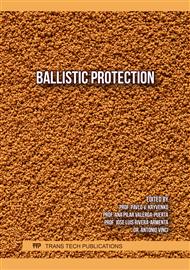[1]
H. Diao, A. Bismarck, P. Robinson, M.R. Wisnom, Pseudo-ductile behaviour of unidirectional fibre reinforced polyamide-12 composite by intra-tow hybridization and damage suppression in thin ply CFRP angle-ply laminates, Composites Part A. 69 (2014) 64-71.
DOI: 10.1016/j.compositesa.2014.11.004
Google Scholar
[2]
M. Fotouhi, M. Jalalvand, M.R. Wisnom, Notch insensitive orientation-dispersed pseudo-ductile thin-ply carbon/glass hybrid composites, Composites Part A. 110 (2018) 29-44.
DOI: 10.1016/j.compositesa.2018.04.012
Google Scholar
[3]
G. Czél, T. Rev, M. Jalalvand, et al., Pseudo-ductility and reduced notch sensitivity in multi-directional all-carbon/epoxy thin-ply hybrid composites, Composites Part A. 104 (2018) 151-164.
DOI: 10.1016/j.compositesa.2017.10.028
Google Scholar
[4]
Y. Swolfs, I. Verpoest, L. Gorbatikh, Recent advances in fibre-hybrid composites: material selection, opportunities and application, Int. Mater. Rev. 64 (2018) 181-215.
DOI: 10.1080/09506608.2018.1467365
Google Scholar
[5]
J.D. Fuller, M.R. Wisnom, Exploration of the potential for pseudo-ductility in thin ply CFRP angle-ply laminates via an analytical method, Compos. Sci. Technol. 112 (2015) 8-15.
DOI: 10.1016/j.compscitech.2015.02.019
Google Scholar
[6]
G. Czél, M.R. Wisnom. Demonstration of pseudo-ductility in high performance glass/epoxy composites by hybridisation with thin-ply carbon prepreg, Composites Part A. 52 (2013) 23-30.
DOI: 10.1016/j.compositesa.2013.04.006
Google Scholar
[7]
M. Jalalvand, G. Czél, M.R. Wisnom, Damage analysis of pseudo-ductile thin-ply UD hybrid composites – a new analytical method, Composites Part A. 69 (2015) 83-93.
DOI: 10.1016/j.compositesa.2014.11.006
Google Scholar
[8]
C. Zhang, Y. Rao, W. Li, Low-velocity impact behaviour of intralayer hybrid composites based on carbon and glass non-crimp fabric, Compos. Struct. 234 (2020) 111713.
DOI: 10.1016/j.compstruct.2019.111713
Google Scholar
[9]
E. Sevkat, B. Liaw, F. Delale, Drop-weight impact response of hybrid composites by impactor of various geometries, Mater. and Des. 52 (2013) 67-77.
DOI: 10.1016/j.matdes.2013.05.016
Google Scholar
[10]
Z. Wu, L. Zhang, Z. Ying, J. Ke, X. Hu, Low-velocity impact performance of hybrid 3D carbon/glass woven orthogonal composite: Experiment and simulation, Composites Part B. 196 (2020) 108098.
DOI: 10.1016/j.compositesb.2020.108098
Google Scholar
[11]
A. Sasikumar, D. Trias, J. Costa, N. Blanco, J. Orr, P. Linde, Effect of ply thickness and ply level hybridization on the compression after impact strength of thin laminates, Composites Part A. 121 (2019) 232-243.
DOI: 10.1016/j.compositesa.2019.03.022
Google Scholar
[12]
E.V. González, P. Maimí, J.R. Sainz de Aja, P. Cruz, P.P. Comanho, Effects of interply hybridization on the damage resistance and tolerance of composite laminates, Compos. Struct. 108 (2014) 319-331.
DOI: 10.1016/j.compstruct.2013.09.037
Google Scholar
[13]
M.T. Dehkordi, H. Nosraty, M. Shokrieh, G. Minak, D. Ghelli, The influence of hybridization on impact damage behavior and residual compression strength of intraply basalt/nylon hybrid composites, Mater. and Des. 43 (2013) 283-290.
DOI: 10.1016/j.matdes.2012.07.005
Google Scholar
[14]
F. Sarasini, J. Tirillò, M. Valente, et al., Hybrid composites based on aramid and basalt woven fabrics: Impact damage modes and residual flexural properties, Mater. and Des. 49 (2013) 290-302.
DOI: 10.1016/j.matdes.2013.01.010
Google Scholar
[15]
A. Wagih, T.A. Sebaey, A. Yudhanto, G. Lubineau, Post-impact flexural behavior of carbon-aramid/epoxy hybrid composites, Compos. Struct. 239 (2020) 112022.
DOI: 10.1016/j.compstruct.2020.112022
Google Scholar
[16]
Y. Swolfs, L. Gorbatikh, I. Verpoest, Fibre hybridisation in polymer composites: a review, Composites Part A. 67 (2014) 181-200.
DOI: 10.1016/j.compositesa.2014.08.027
Google Scholar
[17]
B. Whittingham, I. Marshall, T. Mitrevski, R. Jones, The response of composite structures with pre-stress subject to low velocity impact damage, Compos. Struct. 66 (2004) 685-698.
DOI: 10.1016/j.compstruct.2004.06.015
Google Scholar
[18]
T. Mitrevski, I. Marshall, R. Thomson, R. Jones, Low-velocity impacts on preloaded GFRP specimens with various impact shapes, Compos. Struct. 76 (2006) 209-217.
DOI: 10.1016/j.compstruct.2006.06.033
Google Scholar
[19]
I-H. Choi, I-G. Kim, S-M. Ahn, C-H. Yeom, Analytical and experimental studies on the low-velocity impact response and damage of composite laminates under in-plane loads with structural damping effects, Compos, Sci. Technol. 79 (2010) 1513-1522.
DOI: 10.1016/j.compscitech.2010.05.007
Google Scholar
[20]
H. Saghafi, G. Minak, A. Zucchelli, Effect of preload on the impact response of curved composite panels, Composite Part B. 60 (2014) 74-81.
DOI: 10.1016/j.compositesb.2013.12.026
Google Scholar
[21]
S-T. Chiu, Y-Y. Liou, Y-C. Chang, C-L. Ong, Low-velocity impact behavior of prestressed composite laminates, Mater. Chem. Phys. 47 (1997) 268-272.
DOI: 10.1016/s0254-0584(97)80063-6
Google Scholar
[22]
S.K. Garcia-Castillo, S. Sanchez-Saez, E. Barbero, C. Navarro, Response of preloaded laminate composite plates subject to high velocity impact, J. Phys. IV. 134 (2006) 1257-1263.
DOI: 10.1051/jp4:2006134191
Google Scholar
[23]
S. Heimbs, T. Bergmann, High-velocity impact behaviour of presressed composite plates under bird strike loading, Int. J. Aerospace. Eng. (2012) 372167.
DOI: 10.1155/2012/372167
Google Scholar
[24]
S. Heimbs, T. Bergmann, D. Schueler, N. Toso-Pentecote, High velocity impact on preloaded composite plates, Compos. Struct. 111 (2014) 158-168.
DOI: 10.1016/j.compstruct.2013.12.031
Google Scholar
[25]
A.R. Moallemzadeh, S.A.R. Sabet, H. Abedini, Preloaded composite panels under high velocity impact, Int. J. Impact. Eng. 114 (2018) 153-159.
DOI: 10.1016/j.ijimpeng.2017.12.019
Google Scholar
[26]
M.V. Zhikharev, S.B. Sapozhnikov, O.A. Kudryavtsev, V.M. Zhikharev, Effect of tensile preloading on the ballistic properties of GFRP, Composites Part B. 169 (2019) 524-531.
DOI: 10.1016/j.compositesb.2019.03.026
Google Scholar
[27]
Information on http://www.hccomposite.com.
Google Scholar
[28]
Information on https://npp-termoteks.inni.info.
Google Scholar
[29]
E.V. Leshkov, S.B. Sapozhnikov, Modeling the nonlinear deformation and damage of carbon-aramid fabric composites in tension, Mech. Compos. Mat. 56 (2020) 867-880.
DOI: 10.1007/s11029-020-09906-1
Google Scholar
[30]
W. Xie, W. Zhang, N. Kuang, D. Li, W. Huang, Y. Gao, N. Ye, L. Guo, P. Ren, Experimental investigation of normal and oblique impacts on CFRPs be high velocity steel sphere, Composites Part B. 99 (2016) 292-300.
DOI: 10.1016/j.compositesb.2016.06.020
Google Scholar
[31]
J. Pernas-Sánchez, J.A. Artero-Guerrero, D. Varas, J. López-Puente, Experimental analysis of normal and oblique high velocity impacts on carbon/epoxy tape laminates, Composites Part A. 60 (2014) 24-31.
DOI: 10.1016/j.compositesa.2014.01.006
Google Scholar



